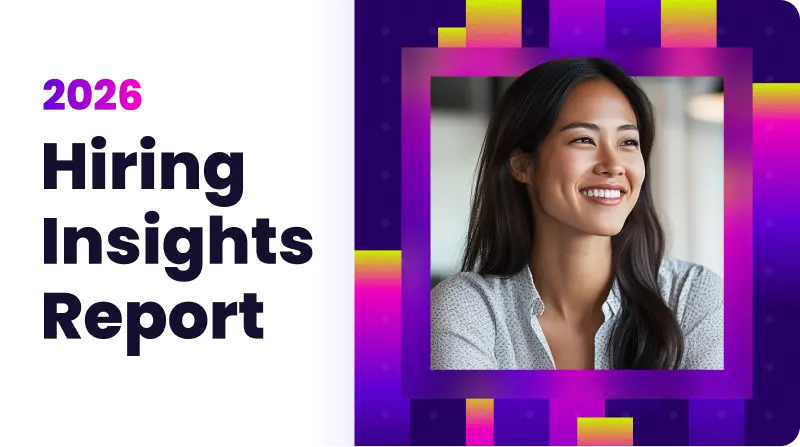Editor’s note: The article below is an excerpt from GoodTime’s 2025 Hiring Insights Report. The entire report is available to view online for free here.
Enterprise organizations—defined here as companies with 5,000 or more employees—face unique hiring challenges that set them apart from smaller organizations. With expansive teams, complex organizational structures, and global operations, talent acquisition at this scale requires navigating significant hurdles, from managing a mix of corporate and high-volume hiring to meeting diverse, localized workforce needs.
This section, based on insights from 126 TA leaders at enterprise companies, explores the key hiring trends and priorities shaping enterprise hiring strategies in 2025.

Unlock 2026’s top hiring strategies: Insights from 500+ TA leaders
Be the first to uncover deep hiring insights specific to your sector — straight from the highest-performing TA teams.

Key enterprise recruitment stats for 2025
Enterprise talent acquisition teams faced mounting challenges in 2024, with only 51.9% of hiring goals achieved—a slight drop from 53.8% in 2023. With the pressures of scale, complexity, and competition, enterprise teams struggled to keep pace. Let’s examine the challenges that contributed to this decline in goal attainment and what they reveal about the current talent market.
Enterprise hiring teams dealt with evolving candidate expectations and internal hurdles in 2024. Retaining top talent emerged as the number one challenge, in line with their peers at smaller companies.
Adding to the complexity, policy changes within companies created friction for TA teams, forcing them to adapt hiring strategies on the fly. Remote and hybrid work preferences also remained a sticking point, as enterprises navigated how to accommodate flexibility without compromising operational goals.
Time-to-hire pressures intensify
With 60% of enterprise TA leaders reporting longer time-to-hire in 2024, delays are increasingly becoming a critical barrier in securing top talent. The complexity of managing cross-functional approvals and hybrid processes often stretches timelines, giving competitors an edge in a tight labor market. To stay competitive, enterprise teams must prioritize solutions that support the fastest possible hiring process.
Layoffs continue to be a reality as organizations’ needs change
Layoffs affected 67% of enterprise organizations this year—an increase from 58% the year prior. While the majority kept workforce reductions below 10%, these cuts reflect the ongoing need for large organizations to recalibrate amidst economic and operational shifts. With talent retention a top challenge, layoffs further underscore the importance of thoughtful workforce planning and strategic hiring investments to stabilize teams and drive resilience.
Candidate experience remains a priority and a challenge
Half of enterprise TA leaders reported that growing candidate demands have increased the touchpoints required in the hiring process, and nearly as many cited the impact of recruitment team turnover on their ability to manage candidate flow.
Interestingly, while some leaders observed a more competitive hiring landscape due to increased demand for talent, others saw the opposite, citing an easing of competition as talent availability grew. Regardless, the rising importance of candidate experience remains clear, indicating the need for agility in managing relationships, navigating fluctuating market conditions, and optimizing processes even amidst team reductions.
“Thinking about that candidate journey: How can we create an environment of delivering as much information as possible in ways that is self-service and direct access for our candidates? So if they’re looking for a job, they can really uncover information, and feel like it’s personalized. And the experience through the entire journey is seamless and effortless.”
-Vanessa Burnaby, VP, Global Talent Acquisition, Twilio
Enterprise talent acquisition embraces a tech-enabled evolution
Over the past year, enterprise talent teams have prioritized efficiency at every stage of the hiring process. Key areas of focus included increasing offer acceptance rates (45%), optimizing automation in hiring workflows (44%), and upgrading hiring technology (40%). Candidate experience remained a central theme, with leaders emphasizing improvements in building relationships, enhancing personalization, and streamlining the overall hiring journey.
Enterprise organizations have gone all-in on AI and automation, deploying these technologies to both simplify and elevate their hiring processes. The most common applications include resume screening and application reviews (53%), analytics and reporting (53%), and interview scheduling (49%).
This shift reflects a maturation in how enterprises approach AI—not just for time savings but as a tool for strategic decision-making. By leaning into advanced automation, these organizations are not only improving speed and efficiency but also enhancing the candidate experience through more intelligent, responsive hiring processes.
Enterprise organizations are embracing SMS and WhatsApp to engage candidates quickly, with 58% using company platforms or texting software. However, 17% still rely on personal cell phones, posing privacy and professionalism risks.
Adopting secure, centralized communication tools not only reduces risks but also reinforces a consistent candidate experience, helping enterprises accelerate hiring at scale without compromising on quality.
What’s ahead for enterprise organizations in 2025?
For 2025, enterprise organizations cite retaining top talent as their top anticipated challenge, followed by skill mismatches, hybrid work issues, and unrealistic compensation expectations. Operational difficulties, such as managing remote processes and high applicant volumes, also remain significant.
Enterprise leaders foresee major shifts in 2025, with 55% pointing to increased recruitment team turnover as a key disruptor. Rapid candidate engagement and building meaningful relationships will be critical, alongside managing larger candidate volumes and more touchpoints.
How enterprise organizations plan to address hiring challenges in 2025
Enterprise organizations are gearing up for 2025 by prioritizing foundational improvements in their hiring processes. Standardizing processes (44%), improving efficiency (43%), and upgrading technology (42%) are top focus areas. Investments in AI and automation remain central, with 40% of leaders planning to utilize AI to streamline hiring. These priorities signal a strategic push toward making hiring more consistent, efficient, and data-driven to tackle anticipated challenges.
94% of enterprise TA leaders are likely or very likely to invest in additional technology to increase hiring efficiency in the coming year. This reflects a strong commitment to scaling their hiring operations and addressing critical bottlenecks. By combining tech adoption with process optimization, enterprise TA teams aim to maximize not just their efficiency, but their adaptability in a relatively unpredictable talent market.




